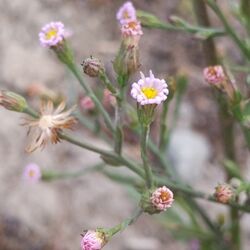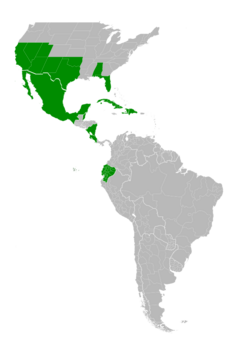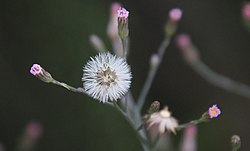Biology:Symphyotrichum parviflorum
| Symphyotrichum parviflorum | |
|---|---|

| |
| S. parviflorum growing at Coyote Hills Regional Park in Alameda County, California | |
| Scientific classification | |
| Kingdom: | Plantae |
| Clade: | Tracheophytes |
| Clade: | Angiosperms |
| Clade: | Eudicots |
| Clade: | Asterids |
| Order: | Asterales |
| Family: | Asteraceae |
| Tribe: | Astereae |
| Subtribe: | Symphyotrichinae |
| Genus: | Symphyotrichum |
| Subgenus: | Symphyotrichum subg. Astropolium |
| Species: | S. parviflorum
|
| Binomial name | |
| Symphyotrichum parviflorum | |

| |
| Native distribution[1] | |
| Synonyms[1][3] | |
|
Basionym
Alphabetical list
| |
Symphyotrichum parviflorum (formerly Symphyotrichum subulatum var. parviflorum) is an annual and herbaceous plant commonly known as southwestern annual saltmarsh aster.[4] It is native to Mexico, the Caribbean, most of Central America, Ecuador, and the southwestern United States. It is also known by the scientific name Symphyotrichum expansum.
Description
Southwestern annual saltmarsh aster usually flowers from July through November, but sometimes into January. It has white, sometimes pink, ray florets surrounding yellow disk florets. As the plant is drying after pollination, each ray floret curls into 1 to 2 coils.[5]
Taxonomy
The basionym of Symphyotrichum parviflorum is Aster parviflorus, and it was first described by Christian Gottfried Daniel Nees von Esenbeck ("Nees") in 1818.[2] It also has been called Symphyotrichum expansum with the basionym Erigeron expansus[3] and Symphyotrichum subulatum var. parviflorum.[5]
Distribution and habitat
Symphyotrichum parviflorum is native to Mexico, the Caribbean, most of Central America, Ecuador, and the southwestern United States. It is an introduced species in central Europe.[1] Flora of North America reports an introduction of the species in Hawaii and Japan . It grows in marshy habitats and roadsides at 0–1,100 meters (0–3,600 feet), sometimes up to 4,000 m (13,100 ft), and it is often considered weedy.[5]
Conservation
(As of December 2021), NatureServe gives no global status rank to this plant. It does rank it as Critically Imperiled in Nevada.[6]
Citations
References
- Flora of North America Editorial Committee, ed. (2006), "Symphyotrichum subulatum var. parviflorum", Flora of North America North of Mexico (FNA), 20, New York and Oxford, http://www.efloras.org/florataxon.aspx?flora_id=1&taxon_id=250068864, retrieved 30 December 2021
- Hassler, M. (8 December 2021). "Symphyotrichum parviflorum (Nees) Greuter – World Plants: Synonymic Checklists of the Vascular Plants of the World". in Bánki, O.; Roskov, Y.; Döring, M. et al.. Species 2000 & ITIS Catalogue of Life, 18 December 2021. Leiden, Netherlands: Naturalis Biodiversity Center. https://www.catalogueoflife.org/data/taxon/8S8YZ. Retrieved 30 December 2021.
- "Aster parviflorus Nees, Syn. Aster. Herb. 29 (1818)". International Plant Names Index (IPNI). Royal Botanic Gardens, Kew. https://www.ipni.org/n/70029027-1.
- "Symphyotrichum expansum Desert American-aster". Arlington, Virginia. 6 December 2021. https://explorer.natureserve.org/Taxon/ELEMENT_GLOBAL.2.130399.
- "Symphyotrichum expansum (Poepp. ex Spreng.) G.L.Nesom" (in en). Royal Botanic Gardens, Kew. 2021. http://www.plantsoftheworldonline.org/taxon/981909-1.
- "Symphyotrichum expansum". Natural Resources Conservation Service PLANTS Database. USDA. 2014. https://plants.usda.gov/core/profile?symbol=SYEX.
Wikidata ☰ {{{from}}} entry
 |


